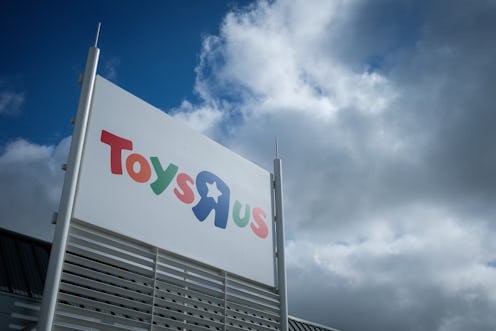
Sad news for ‘90s kids everywhere today: Toys R Us is closing all of its U.S. stores — nearly 800 of them — and liquidating their assets. Never again shall we roam the aisles of the once-great toy mecca; never again shall we feel the excitement and possibility inspired simply by walking through those automatic doors that parted as if by magic for us. Farewell, my brightly-colored childhood! Farewell!
In a press release dated March 15, 2018, Toys R Us Inc. announced that it has filed for court approval to “begin the process of conducting an orderly wind-down of its U.S. business and liquidation of inventory in all 735 of the Company’s U.S. stores, including stores in Puerto Rico.” The chain filed for bankruptcy in September of 2017, and although attempts were made over the ensuing six months to cut deals that would lift it out of bankruptcy, it seems that the end has finally arrived. (If, by the way, you have any Toys R Us gift cards burning a hole in your pocket, you have 30 days to use them.)
Said chairman and CEO Dave Brandon in a press release, “I am very disappointed with the result, but we no longer have the financial support to continue the Company’s U.S. operations. We are therefore implementing an orderly process to shutter our U.S. operations and will pursue going concern sales or reorganizations of certain of our international businesses, while our other international businesses consider their options.” He added, “This is a profoundly sad day for us as well as the millions of kids and families who we have served for the past 70 years.”
Founded in 1948 by Charles P. Lazarus as a Washington,D.C.-area baby furniture store, Toys R Us wouldn’t become… well, Toys R Us until about a decade later. After Children’s Bargain Town, as it was initially known, began receiving requests not just for baby furniture, but also baby toys, Lazarus began stocking playthings; then, in 1957, he moved fully into the world of toys, adopting the name Toys R Us for his venture. The idea was essentially to make it a supermarket for toys: As the Washington Post described it, “Long aisles. Products stacked high. Variety. Big enough to get products at discounts to pass on to shoppers.” And it was, as they say, a hit.
Lazarus sold the company for the first time in 1966; it was bought by Interstate Sales, while Lazarus stayed on as head of the company’s toys division. The mascot Geoffrey the Giraffe began appearing in 1969, while the first Kids R Us clothing store opened in 1983. In 1994, though, Lazarus retired— and that seems to have been the beginning of the end for the company.
The next several decades would be rife with management changes, and repeated efforts to turn the company around failed. Other big box stores became competitive with Toys R Us, eventually either matching or surpassing the company in sales; it began to have trouble keeping up with these competitors (as Brandon noted in an SEC filing in 2017 according to CNN, Toys R Us “had fallen behind… ‘on various fronts, including with regard to general upkeep and the condition of our stores’”); its clothing store chain, Kids R Us, which had opened in 1983, closed without fanfare in 2003; and, of course, the rise of Amazon and other online retailers cut into sales. Acquisitions of two other fabled toy store brands, KB Toys and FAO Schwarz, also failed to change Toys R Us’ fortunes; KB Toys is now defunct, and FAO Schwarz was sold again to the ThreeSixty Group in 2016.
Following 2017’s Chapter 11 bankruptcy filing, a similar setback occurred in the company’s UK operations; in December, it was announced that at least 26 stores covering around 800 jobs would be closing in the upcoming year. And then, in January 2018, things got even worse on the U.S. front: Plans were put into place to close 182 stores nationwide. Another blow for the UK business came in February, when Toys R Us UK went into administration in order to begin “an orderly wind-down” and liquidation.
And now, it looks like the end is here for the U.S.business, as well; with the shutdown of all Toys R Us and Babies R Us locations in the United States, around 30,000 jobs will be lost, according to Reuters. Additionally, although the stores remain open in international locations other than the UK, Toys R Us is also “pursuing a …reorganization and a sale process for its Canadian and international operations in Asia and Central Europe,” while “operations in Australia, France, Poland, Portugal, and Spain are considering their options in light of this announcement, including potential sale processes in their respective markets,” states a press release. CNBC reported on Wednesday that a possible plan the company might be pursuing would sell off the Canadian branch and keep open about 200 U.S. stores; however, this plan may not pan out. CNBC’s sources claim that there is no buyer yet, although there may be “several circulating.”
In the meantime, though, those of us who grew up with Toys R Us as a fixture of our youths — even just in terms of the commercials and the newspaper inserts, let alone whether or not you regularly got to actually go to the stores themselves — will have to square with the fact that it is no more. Farewell, Toys R Us; my childhood gently weeps for you. I hope there are Tamagotchis and action figures aplenty for you wherever toy stores go when they die.